Ernest Thesiger’s
costumes, pageantry, and parties



“I went as Death, in black draperies, with a skull-mask wreathed in scarlet poppies. On the many fans that Conder afterwards painted representing the ball, there is nearly always to be found my macabre figure in the corner.”
Invitation by artist Charles Conder to his fancy-dress ball, February 18, 1905
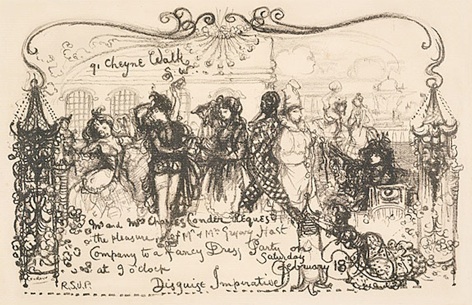
Ernest Thesiger, Practically True
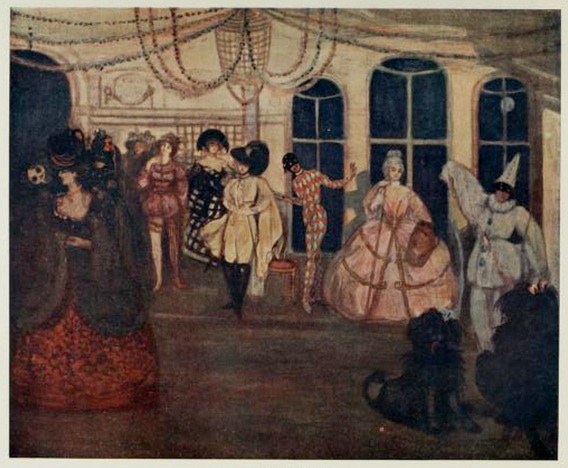
This painting by Charles Conder, entitled “Masquerade,” may depict Ernest as Death peering into a woman’s face at far left.
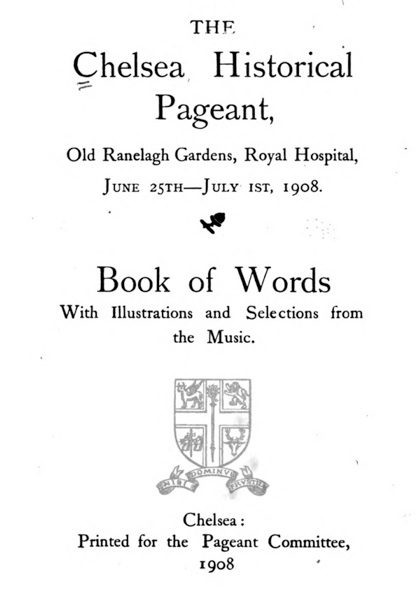
Ernest on the Dress Committee of the Chelsea Historical Pageant, 1908
Ernest as King Edgar, also as producer and costume designer for the “Saint Dunstan and the Monks” scene presented by Holy Trinity Church, Chelsea, at the English Church Pageant, June 1909.
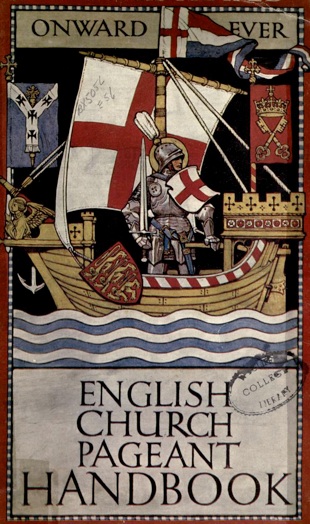
Christmas Pantomime Ball, December 4, 1912, to benefit the funds of the University College Hospital. Ernest in charge of dresses for the Sleeping Beauty Pageant, and performed as the Court Physician.
The Arabian Nights Ball, December 1912
“Special feature of the Arabian Nights Ball: Rehearsing the famous Provencal peasant dance
It was arranged that a very special feature of the Arabian Nights ball at Covent Garden, last week, should be the dancing of the farandole for, it was said, the first time in England. The farandole is an old Provencal peasant dance - a chain dance - in which those taking part join hands, or hold the ends of handkerchiefs, and then, turning each other’s arms, revolve in a spiral round a single couple. In one figure, they pass beneath the arms of these two ‘oranges-and-lemons’ fashion. Originally, the dancers, with linked hands, would traverse the whole village on Saints’ Days and other festivals. Many explanations of its origin have been attempted. Some say that it is identical to the old Greek Geranos (Crane Dance), which Maurice Emmanuel declared had nothing to do with cranes, but symbolized Theseus leading the captives out of the Labyrinth in single file. It was arranged that the dance should be given at Covent Garden to special music sent from Spain, and that Mr. Ernest Thesiger should play an antique drum and Mr. Cosmo Gordon-Lennox the fife. “
The Sketch, December 18, 1912
Mr. Thesiger, who was not supplied with the real old drum which he will beat on the night of the 12th, at first emphasized the beat of the music by clapping his hands, but soon with ingenious spirit, he picked up an empty red fire bucket, and, thumping upon it with a stick, gave a capital imitation of the drumming accompaniment.
The Standard, December 4, 1912
“Player of the drum for the farandole at the Arabian Nights Ball: Mr. Ernest Thesiger - as ‘The Green God.’”
The Sketch, December18, 1912

“At the Women’s Ball on Wednesday one of the very prettiest features promises to be the Cornish floral dance, for which Lady Lavery has got together a perfect bevy of London’s youthful beauty. The dancers are to wear a white Greek dress (of Lady Lavery’s own design), with very becoming head-dresses of chintz tied with colored ribbons, and the dancers are also to have flowing draperies of various colors hanging down at the back, the long ends being caught up again over the wrist. Lady Diana Manners and Lady Lavery are to lead a slow and stately march of couples down the ball, and when they have opened out the floral dancers, led by Mr. Ernest Thesiger as Pan playing his pipes, will come skipping down to the strains of the old air, after which they form into fours for hands across and back again, and in this way the dance proceeds...”
Dundee Courier, May 26, 1919
“The women had every reason to be proud of their ball at the Albert Hall last week in aid of the Chelsea Hospital for Women. That it was organized for them by a man, Mr G. Sherwood Foster, shows the good feeling between the sexes. It was a beautiful ball; the decorations and lighting were lovely, and the costumes did justice to their setting. The Princess Royal, Prince and Princess Arthur of Connaught, Princess Maud, and Princess Marie Louise, who was of another party, all expressed their great pleasure at the lovely sight the ball afforded them from the King’s box. Especially were they pleased when the shower of multi-colored air-balls and the thousands of yards of bright-hued paper ribbon descended from baskets swung aloft on the dancers, just as the Floral Maidens were in their hottest pursuit of the agile Pan of Mr. Ernest Thesiger.”
The Illustrated London News, June 7, 1919
“Ernest Thesiger, who is considered one of the best actors we have, has been offered the part of a ‘dame’ in a London pantomime. Remembering how he dressed up as a duchess at a fancy dress party some time ago and stood at the top of the stairs to receive the guests in the manner of an exceptionally imposing nineteenth century grande dame, it can easily be imaged how suitable he is for the part. Mr. Thesiger, by the way, is a member of Lord Chelmsford’s family, and in contrast to his theatrical work during the week, is a most prominent member of Holy Trinity Church, Sloane Street, London, where he regularly assists in taking the collection.”
Dundee Courier, Sept 30, 1924
Photo by Sasha, 1926
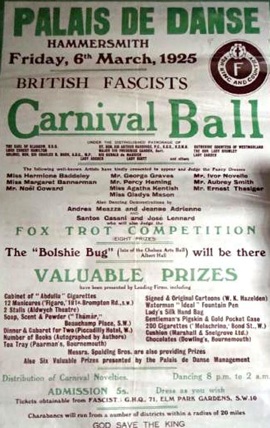
Ernest was one of the costume judges at the British Fascists Carnival Ball, 1925

“Lady Londonderry and her second daughter, Lady Margaret Stewart, Mr. Ernest Thesiger, and Mr. Gilchik, the black and white artist, pooled their critical faculties at the dance of the Society of Women Artists the other night to select the four best costumes.”
Dundee Courier, March 7, 1929
Dundee Courier, December 20, 1929
“Lord Hoadley attended the Three Arts Fairy Tale Ball at Grosvenor House, London, dressed as an Arab sheik. He is head of the Mohammedan Church in this country. He was the best boxer of his weight at Cambridge, and has written standard text-books of boxing. Sir Thomas Beecham was present in what might call his working clothes - ordinary evening dress. Sir Nigel Playfair was sporting enough to wear a Bohemian coat of velvet, and Mr. Ernest Thesiger had a fantastic Oriental costume which won the first prize for men.”
"Mr. Ernest Thesiger, the well-known actor, in flowing sombre black robes impersonated Medusa."
The Great Urban Dionysia, April 4, 1929
The Winnipeg Tribune, April 27, 1929
Dundee Courier, January 10, 1930
“Miss Edith Dawkins, daughter of Lady Bertha Dawkins, one of the Queen’s ladies-in-waiting, is helping to organize the ‘When We Were Very Young’ ball, which takes place at the Savoy Hotel, London, next Wednesday. Mr. Ernest Thesiger is to lead off with ‘A Few Words from Nurse.’”

“One of the funniest figures was that of Mr. Ernest Thesiger, who was in grotesque pink tights.”
Norman Hartnell’s Circus Party, 1929
The Daily Express, July 3, 1929
“Youth in Society of the present day always enjoys an excuse for dressing up, and the special matinee which the Queen has promised to attend tomorrow provided much amusement behind the scenes this afternoon at the Chelsea Palace. Chelsea china pieces, one of which has been lent by the Queen to be portrayed by a living figure, are to be represented by young people who have to submit to ‘glazed’ faces and stand motionless for several minutes. Mr. Ernest Thesiger, who has made the designs from the old china, rehearsed his young ladies on the stage, and the dresses were tried on with some difficulty in many cases. Stiff American cloth, painted with gold and floral garlands, has been used to make the costumes, and faces have been masked in heavy white grease paint with blots of red for ‘china’ cheeks.”
Western Morning News, March 26, 1930
Chelsea China Pageant in aid of the Chelsea Housing Scheme, costume designs by Ernest. March 26, 1930
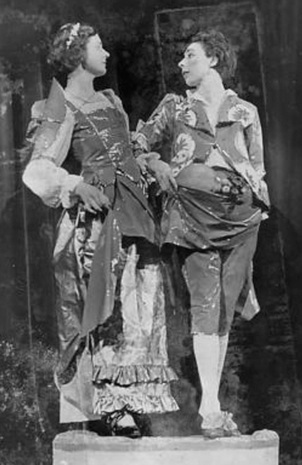
Hon. Mrs. Gordon Ives and Miss Rosalind Gordon
“Sir Edwin Lutyens has cleverly transformed Albert Hall, for the Coronation Costume Ball on May 13, into a loverly medieval garden, which will provide a fitting background for 5,000 dancers and for the processions which, during the evening, will pass along representing every phase of modern and ancient drama and comedy...Sir Cedric Hardwicke, Dame Sybil Thorndike, Sir John Martin Harvey, Edith Evans, Ivor Novello, Ernest Thesiger and Cyril Maude are among the famous actors who will impersonate characters.”
The Illustrated Sporting and Dramatic News, July 6, 1918

“The Theatrical Garden Party at the Royal Botanic Garden. Mr. Ernest Thesiger (the Bertram Tully of ‘A Little Bit of Fluff’) and Miss Joyce Carey offer some bargains in hats - note the ‘fishy’ one.”
“Actor-Milliner. Mr. Ernest Thesiger and Miss Lilian Braithwaite will have a hat stall at the Theatrical Garden Party. The comedian is at present busy renovating hats that have been sent to him. His goods will not be ‘duds.’”
Daily Mirror, June 10, 1918
The Sketch, June 30, 1920

The Theatrical Garden Party, in aid of the Actors’ Orphanage, 1920
“Mr. Ernest Thesiger, a cousin of Lord Chelmsford, who managed to make himself quite unlike any of his various personalities when he put on godliness and a beard for the Church Pageant, is particularly learned in disguises. The cap and bells suit him just as well as a halo, and he is equally intent on the business in hand, whether he is painting water-colours in Morocco or imitating Sarah Bernhardt in his studio, for he is an artist as well as a mummer. When Church Pageants are not on hand, a fancy-dress dance will serve his turn, and not long ago, at his own very amusing party in the Chelsea Town Hall, one of his water-colours, given as a prize, fell to the lot of a Beardsley Archangel, although there was a strong feeling that Mr. Thesiger should have kept it himself. Surely he earned another at Colchester?”
The Sketch, June 30, 1909
In aid of the Brompton Hospital, the entertainment for the “When We Were Very Young” ball was specially written and arranged by Douglas Byng. The ball, whose patrons were the king and queen, aimed to raise £100,000 for the Brompton Hospital for Consumption. The cast included Ernest Thesiger, Viola Tree, Florence Desmond and Cicely Courtneidge.
“The moderns are discovering that the Victorians were after all rather attractive and amusing people - that there was, in fact, something about them which is worth reproducing in the form of an entertainment. A group of those who love ‘making up’ have enlisted the services of well known people whose memories go back to Queen Victoria, and between them they are organizing a series of tableaux vivants to be given at a ball shortly in which Society and the stage will present little pictures of life in what seems a far-off day to young folk of twenty. Queen Victoria herself will be impersonated with the Prince Consort, and there will be Grace Darling, Ellen Terry, and Florence Nightingale at different stages of their careers. The Lord Salisbury of the day will be seen in a tableau, and so also will W.G. Grace, Fred Archer, and General Gordon. Mr. Ernest Thesiger, the well-known actor, is busy rehearsing make-up for impersonating Joseph Chamberlain and there is to be a charming item in which Queen Alexandra, as Princess Alexandra of Denmark, will be represented.”
Portsmouth Evening News, February 5, 1931
Viscount Clifden was among those who accepted invitations to be present at a party given by Mr. Ernest Thesiger at the Saville Theatre, London.
Western Morning News, January 17, 1939
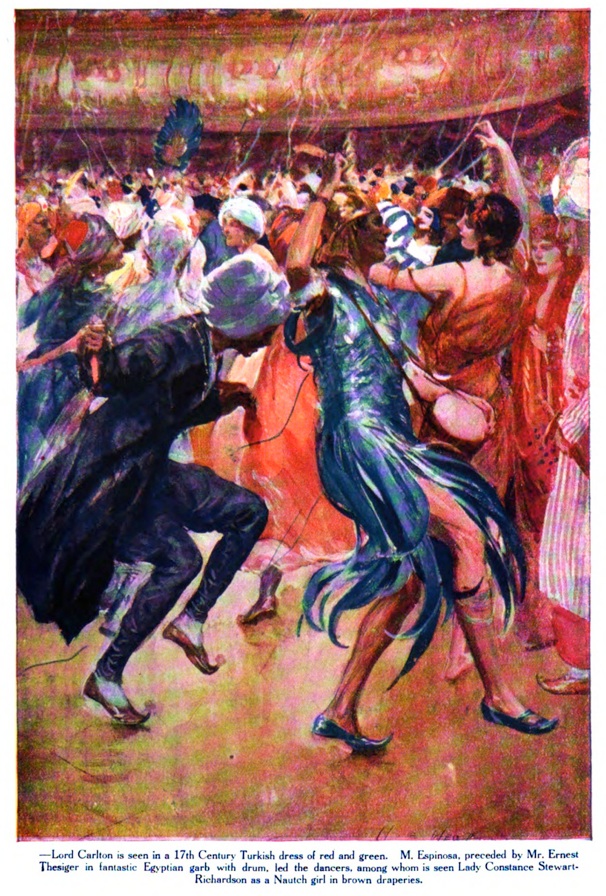
Pearson’s Magazine, v. 36, 1913


Theatricals and tableaux at the Corn Exchange, Melton organized by the Hon. Mrs. Gretton on behalf of the funds of the Melton and Framland Nursing Associations, February 26, 27 1930. “The producer was Mr. Ernest Thesiger, who is noted throughout the theatrical world in that capacity, and he made an exceedingly effective and charming show.”
Grantham Journal, March 1, 1930
Ernest carried a banner for the Men’s League for Women’s Suffrage in the Women’s Coronation Procession through London on June 17, 1911

Gloucester Echo, May 3, 1937
Ernest with Gladys Cooper and her two children at the Theatrical Garden Party on the Royal Hospital grounds in aid of theatrical charities.
The Sphere, July 8, 1922
“Douglas Byng once wrote a pantomine; it was presented with a very starry cast at the 50-50 Club. The occasion (for it only ran one night) was Ivor Novello’s birthday. I appeared as the Fairy Queen.
Whenever the villain was at his very worst - he was, of course, the Demon King - I popped up and frustrated his iniquities, and in the end brought the happy lovers to everlasting bliss.
That is the part I should like to play in real life. To frustrate and thwart the dictators who upset our peace - the killjoys who mar our happiness - to help the impoverished, down-trodden heroes, and finish up assigning them to lovely heroines.
What a role!”
Ernest Thesiger, The Era, January 1, 1936
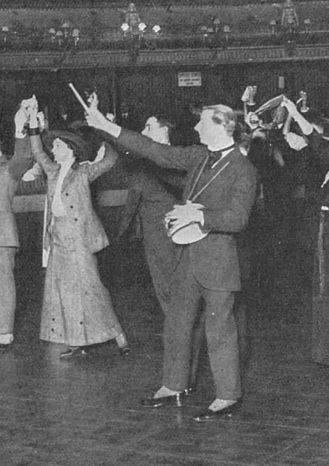

The Sketch, November 9, 1927
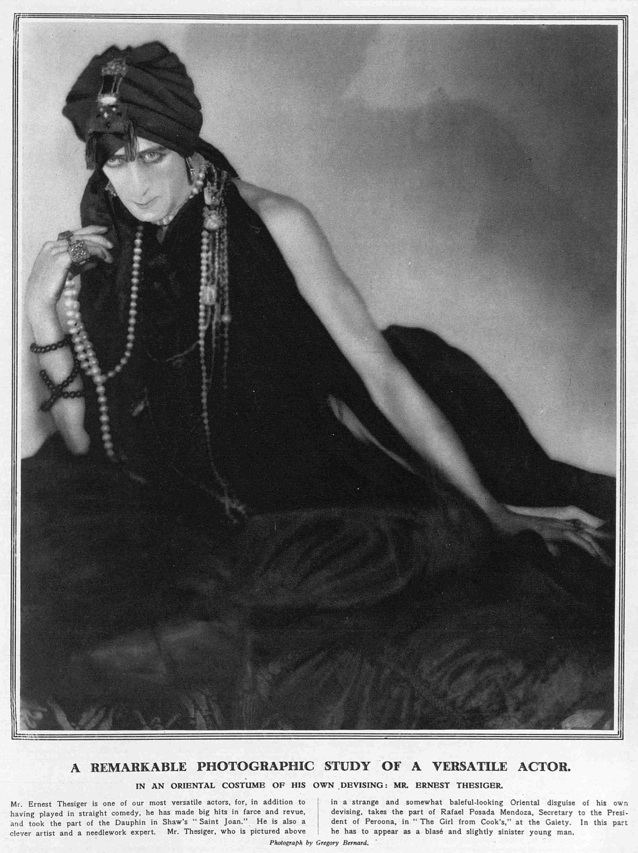
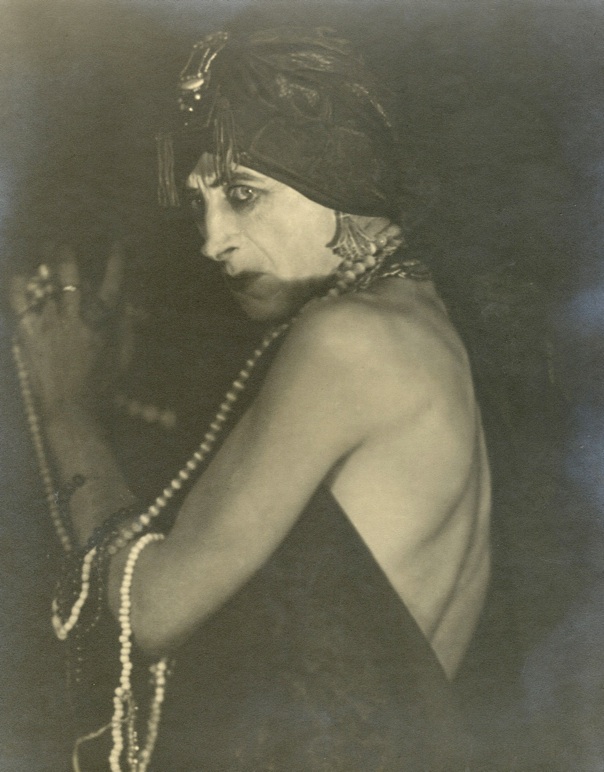
Costume apparently inspired by “The Harpy” by Robert W. Service. Written on the back of this photo: 'The Devil has entered the prompter's box. And the play is ready to start.' Photo: University of Bristol/ArenaPal
The Illustrated Sporting and Dramatic News, February 21, 1931
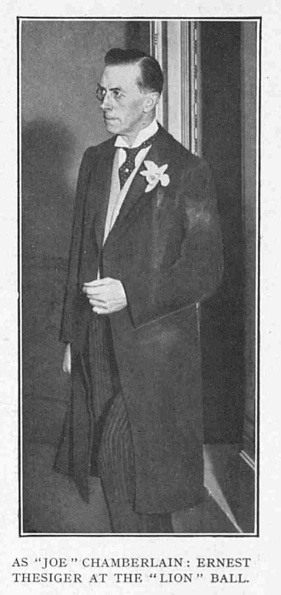
“...Mr. Ernest Thesiger was clad in tomato tights, and had a black wig, huge gold rings in his ears, and green shorts...”
The Sketch, July 10, 1929
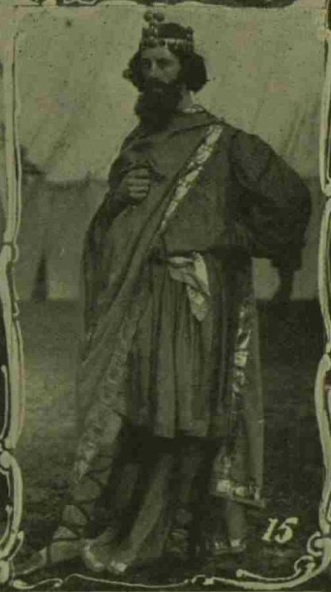
The Bystander, December 11, 1912

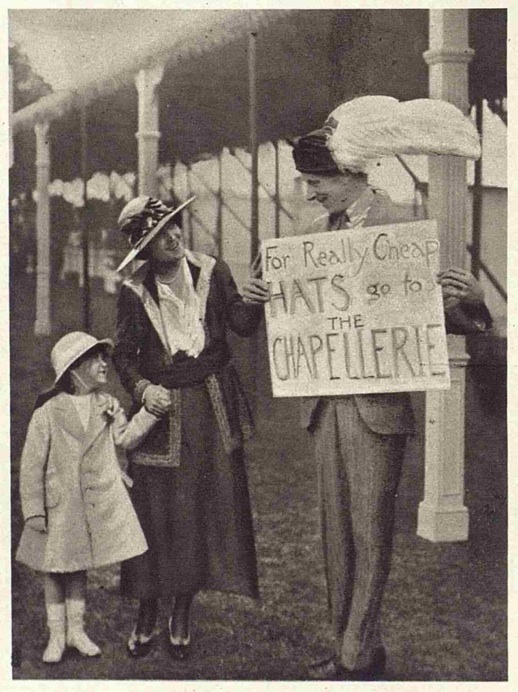
The Sketch, July 3, 1918


